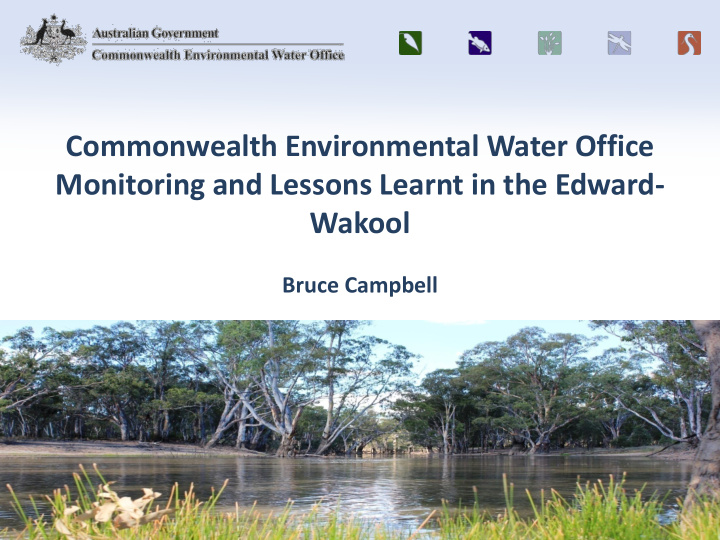



Commonwealth Environmental Water Office Monitoring and Lessons Learnt in the Edward- Wakool Bruce Campbell
Why are we here? Two reasons: To recognise concerns expressed by the local community around the Edward-Wakool monitoring and evaluation (M&E) arrangements. To address action items about M&E and the LTIM project from the MLD CSC: Description of LTIM and accountabilities. Consideration of the range of outcomes (positive, negative and neutral) from previous M&E activities.
Long term monitoring projects Seven key representative areas: Gwydir, Lachlan, Edward-Wakool, Murrumbidgee, Goulburn, Lower Murray and The Junction of the Warrego and Darling $30 million program over 5 years.
Long term monitoring projects Who is accountable for monitoring and evaluation: Ultimately the CEWO/CEWH is responsible for the monitoring and evaluation of Commonwealth environmental water. The MDFRC has been engaged as the M&E Advisor . Providing advice on program design and basin scale evaluation. CSU is the lead M&E Provider in the Edward-Wakool, in a consortium which includes Murray LLS and NSW DPI (Fisheries). CEWO designed the program, and contracted the M&E Advisor/Providers
Long term monitoring projects Who is accountable for monitoring and evaluation (Cont): The Edward-Wakool Stakeholder Committee is the primary body for community engagement with the LTIM project. Implementation of the LTIM project within the CEWO has recently been handed over to the Delivery Teams – Bruce, Damian, Thomas and Linda (Edward-Wakool). LTIM does not replace all past M&E for example: SAM – LLS & Fisheries Basin Plan – MDBA WSP – NSW – NOW/OEH Riverbank – OEH
Past Monitoring Sites in the Edward-Wakool
What Products will LTIM Produce/Contribute to? The M&E Plan is being finalised by the CEWO for publication LTIM Reports include: Quarterly progress reports Annual area evaluation reports - results in the past year and overall Basin evaluation reports (cumulative annual and 5 year reports) Other LTIM Products that may be developed: Factsheets Newsletters Other CEWO documents: Annual Planning Documents Adaptive Management Reports (internal)
2012-13 and 2013-14 Short Term Monitoring Reports Are being finalised for publication in the coming weeks CEWO Website – publish in full How would EWSC like to be engaged on these reports? Adaptive Management Some learning already Workshop – Adaptive Management/Annual Planning. Late summer/early autumn
Adaptive Management and Lessons Learnt Preliminary: for discussion at a workshop with EWSC Recession flows benefit aquatic vegetation and fish Cod demonstrated a preference for the upper Wakool unregulated flows over the Yallakool during e-flow delivery The refuge pool at the junction of the Wakool-Yallakool is a critical area for large bodied native fish - implications Flows and slack-water habitat for shrimp, frogs and invertebrates Constraints management and good neighbour policy Objective setting
Adaptive Management and Lessons Learnt (Cont.) Preliminary Findings from 2012-13: for discussion at the EWSC Workshop. Water quality (salinity) improved in Tuppal Creek Improved condition of veg condition in JCGC Spring/summer Yallakool Creek flows improved aquatic veg No increased reproduction/recruitment for zooplankton, cod, perch or frogs in Yallakool Creek & Colligen Creek Maintained movement conditions for native fish No water quality issues caused by use of e-water in 12-13 No increased aquatic veg in Yallakool Creek or Colligen Creek due to late summer/autumn flows Maintained longitudinal connectivity (along the Yallakool Creek channel) No increase in lateral connectivity (flood runners to Yallakool Creek channel) Lower shrimp numbers in Colligen Creek & Yallakool Creek compared to sites not getting e-water
Managing the Commonwealth’s holdings
Joint effort, awareness and understanding will…. Localism is about meaningful engagement. It is not about delegating statutory decision making responsibilities. Rather, it’s about... Informing decisions about how to best use Commonwealth water, and Promoting shared knowledge and understanding through monitoring - water quality, increased native fish and birds and healthier vegetation and wetlands.
What have we heard? SAM and LTIM Sites Some extra SAM sites included (some decreases in frequency) Can’t afford do everything Can others step up? Data sharing and analysis Agree - must find a cost effect approach Timeframes have been too long Investigating and implementing solutions
What have we heard? Engaging on M&E activities Quarterly reports and updates on activities Concern that some landowners are not aware of activities on or adjacent to their properties. What can be done? Adaptive management workshop. Socio-economic impacts Two issues: direct impacts of Commonwealth environmental water use, and broader impacts of Basin Plan. CEWO focus must be on direct impacts of Commonwealth environmental water use. For discussion with the EWSC.
What have we heard? Concerns about lack of real time water quality data DO data collection under LTIM is via non-telemetered data loggers, downloaded periodically. For discussion with EWSC and LLS. Concern? Proposed approach?
Discussion How would you like us to engage on adaptive management? EWSC Broader Community e.g. WRA or EWAA AGM?
We welcome feedback Contact: Bruce Campbell Bruce.Campbell@environment.gov.au or Linda Duffy Linda.Duffy@environment.gov.au or 0419 188 430 www.environment.gov.au/water /cewo
Recommend
More recommend